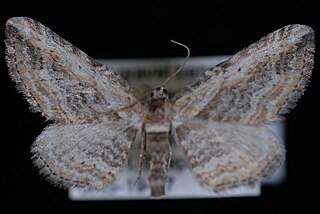Homolagoa is a monotypic moth genus of the family Noctuidae. Its only species, Homolagoa grotelliformis, is found in North America. Both the genus and species were first described by William Barnes and James Halliday McDunnough in 1912.

Cymatophora is a genus of moths in the family Geometridae erected by Jacob Hübner in 1812. It is monotypic, being represented by the single species, the giant gray moth. It is found mostly in the south-eastern United States. It is found in North America.
Eumacrodes is a monotypic moth genus in the family Geometridae described by Warren in 1905. Its only species, Eumacrodes yponomeutaria, first described by Achille Guenée in 1858, is found in the Caribbean and North America.
Pseudhapigia is a monotypic moth genus of the family Notodontidae. Its only species, Pseudhapigia brunnea, is found in North America including its type location in Guadalajara, Mexico. The genus and species were first described by William Schaus in 1901.
Didugua is a monotypic moth genus of the family Notodontidae. Its only species, Didugua argentilinea, the silvered prominent, is found in North America. Both the genus and species were first described by Herbert Druce in 1891.

Prochoerodes amplicineraria is a species of geometrid moth in the family Geometridae. It is found in North America.
Heterocampa cubana, the Cuban heterocampa moth or sunflower moth, is a species of moth in the family Notodontidae. It was first described by Augustus Radcliffe Grote in 1866 and it is found in Cuba and the US state of Florida.

Pseudorgyia russula is a species of moth in the family Erebidae. It is found in North America.

Destutia excelsa is a species of moth in the family Geometridae first described by Strecker in 1878. It is found in North America.

Calledapteryx is a monotypic scoopwing moth genus in the family Uraniidae. Its only species, Calledapteryx dryopterata, the brown scoopwing moth, is found in eastern North America. Both the genus and species were first described by Augustus Radcliffe Grote in 1868.

Fernaldella fimetaria, the green broomweed looper, is a species of geometrid moth in the family Geometridae. The species was first described by Grote and Robinson in 1870 It is found in Central and North America.
Heterocampa zayasi, the blue moor-grass moth or zaya heterocampa, is a species of moth in the family Notodontidae. It was first described by Torre and Alayo in 1959 and it is found in Cuba.
Fernaldella stalachtaria is a species of geometrid moth in the family Geometridae. It is found in North America.

Xanthorhoe fossaria is a species of geometrid moth in the family Geometridae. It is found in North America.
Xanthorhoe mirabilata is a species of geometrid moth in the family Geometridae.

Prochoerodes forficaria is a species of geometrid moth in the family Geometridae. It is found in North America.

Sideridis congermana, or the German cousin, is a species of cutworm or dart moth in the family Noctuidae. It is found in North America.

Horisme incana is a moth in the family Geometridae first described by Louis W. Swett in 1917. It is found in North America.

Plataea ursaria is a species of geometrid moth in the family Geometridae. It is found in North America.

Hydriomena edenata is a species of geometrid moth in the family Geometridae. It is found in North America.












